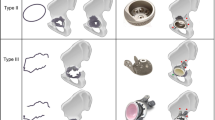Abstract
The anterolateral approach in the supine position provides excellent visualization of the acetabulum. The main advantage of the approach, a low dislocation rate, has been demonstrated in the literature, while the purported disadvantage of abductor dysfunction has not been clearly delineated in the literature. The technique requires meticulous attention to preservation of the gluteus medius and minimus tendons. Impingement and dislocation are avoided by careful attention to the preparation of acetabulum, critical assessment of the implanted components, and intraoperative trialing. Leg lengths are assessed through direct palpation of the malleoli. Routine use of postoperative hip precautions is not necessary when this approach is utilized. The anterolateral approach in the supine position allows for a reproducible result with a low dislocation rate.
Level of Evidence: Level V, therapeutic study. See the Guidelines for Authors for a complete description of levels of evidence.







Similar content being viewed by others
References
Barber TC, Roger DJ, Goodman SB, Schurman DJ. Early outcome of total hip arthroplasty using the direct lateral vs. the posterior surgical approach. Orthopedics. 1996;19:873–875.
Barrack RL. Dislocation after total hip arthroplasty: implant design and orientation. J Am Acad Orthop Surg. 2003;11:89–99.
Demos HA, Rorabeck CH, Bourne RB, MacDonald SJ, McCalden RW. Instability in primary total hip arthroplasty with the direct lateral approach. Clin Orthop Relat Res. 2001;393:168–180.
D’Lima DD, Urquhart AG, Buehler KO, Walker RH, Colwell Jr CW. The effect of the orientation of the acetabular and femoral components on the range of motion of the hip at different head-neck ratios. J Bone Joint Surg Am. 2000;82:315–321.
Downing ND, Clark DI, Hutchinson JW, Coclough K, Howard PW. Hip abductor strength following total hip arthroplasty:a prospective comparison of the posterior and lateral approach in 100 patients. Acta Orthop Scand. 2001;72:215–220.
Frndak PA, Mallory TH, Lombardi Jr AV. Translateral surgical approach to the hip. The abductor muscle “split.” Clin Orthop Relat Res. 1993;295:135–141.
Horwitz BR, Rockowitz NL, Goll SR, Booth Jr RE, Balderston RA, Rothman RH, Cohn JC. A prospective randomized comparison of two surgical approaches to total hip arthroplasty. Clin Orthop Relat Res. 1993;291:154–163.
Jolles BM, Bogoch ER. Posterior versus lateral surgical approach for total hip arthroplasty in adults with osteoarthritis. Cochrane Database Syst Rev. 2006;19;3:CD003828.
Lewinnek GE, Lewis JL, Tarr R, Compere CL, Zimmerman JR. Dislocations after total hip replacement arthroplasties. J Bone Joint Surg Am. 1978;60:217–220.
Madsen MS, Ritter MA, Morris HH, Meding JB, Berend ME, Faris PM, Vardaxis VG. The effect of total hip arthroplasty surgical approach on gait. J Orthop Res. 2004;22:44–50.
Mallory TH, Lombardi Jr AV, Fada RA, Herrington SM, Eberle RW. Dislocation after total hip arthroplasty using the anterolateral abductor split approach. Clin Orthop Relat Res. 1999;358:166–172.
Marumaya M, Feinberg JR, Capello WN, D’Antonio JA. The Frank Stinchfield award:Morphologic features of the acetabulum and femur:anteversion angle and implant positioning. Clin Orthop Relat Res. 2001;393:52–65.
Masonis JL, Bourne RB. Surgical approach, abductor function, and total hip arthroplasty dislocation. Clin Orthop Relat Res. 2002;405:46–53.
Moskal JT, Mann III JW. A modified direct lateral approach for primary and revision total hip arthroplasty:a prospective analysis of 453 cases. J Arthroplasty. 1996;11:255–266.
Murray DW. The definition and measurement of acetabular orientation. J Bone Joint Surg Br. 1993;75:228–232.
Nishii T, Sugano N, Miki H, Koyama T, Takao M, Yoshikawa H. Influence of component positions on dislocation. Computed tomographic evaluations in a consecutive series of total hip arthroplasty. J Arthroplasty. 2004;19:162–166.
Peak EL, Parvizi J, Ciminiello M, Purtill JJ, Sharkey PF, Hozack WJ, Rothman RH. The role of patient restrictions in reducing the prevalence of early dislocation following total hip arthroplasty. A randomized, prospective study. J Bone Joint Surg Am. 2005;87:247–253.
Ranawat CS, Maynard MJ. Modern techniques of cemented total hip arthroplasty. Tech Orthop. 1991;6:17–25.
Ritter MA, Harty LD, Keating ME, Faris PM, Meding JB. A clinical comparison of the anterolateral and posterolateral approaches to the hip. Clin Orthop Relat Res. 2001;385:95–99.
Rodgers A, Walker N, Schug S, McKee A, Kehlet H, van Zundert A, Sage D, Futter M, Saville G, Clark T, MacMahon S. Reduction of post-operative mortality and morbidity with epidural or spinal anaesthesia: results from overview of randomized trials. BMJ. 2000;321:1493.
Usrey MM, Noble PC, Rudner LJ, Conditt MA, Birman MV, Santore RF, Mathis KB. Does neck/liner impingement increase wear of ultrahigh-molecular-weight polyethylene liners? J Arthroplasty. 2006;21:65–71.
Vicar AJ, Coleman CR. A comparison of the anterolateral, transtrochanteric, and posterior surgical approaches in primary total hip arthroplasty. Clin Orthop Relat Res. 1984;188:152–159.
Walter WL, Insley GM, Walter WK, Tuke MA. Edge loading in third generation alumina ceramic-on-ceramic bearings. Stripe wear. J Arthroplasty. 2004;19:402–413.
Walter WL, O’Toole GC, Walter WK, Ellis A, Zicat BA. Squeaking in ceramic-on-ceramic hips. The importance of acetabular component orientation. J Arthroplasty. 2007; 22:496–503.
Yamaguchi M, Akisue T, Bauer TW, Hasimoto Y. The spatial location of impingement in total hip arthroplasty. J Arthroplasty. 2000;15:305–313.
Author information
Authors and Affiliations
Corresponding author
Additional information
Each author certifies that he or she has no commercial associations (eg, consultancies, stock ownership, equity interest, patent/licensing arrangements, etc) that might pose a conflict of interest in connection with the submitted article; one of the authors (RHR) is a Consultant to Stryker Orthopaedics (Mahwah, NJ).
About this article
Cite this article
Austin, M.S., Rothman, R.H. Acetabular Orientation: Anterolateral Approach in the Supine Position. Clin Orthop Relat Res 467, 112–118 (2009). https://doi.org/10.1007/s11999-008-0523-x
Received:
Accepted:
Published:
Issue Date:
DOI: https://doi.org/10.1007/s11999-008-0523-x




